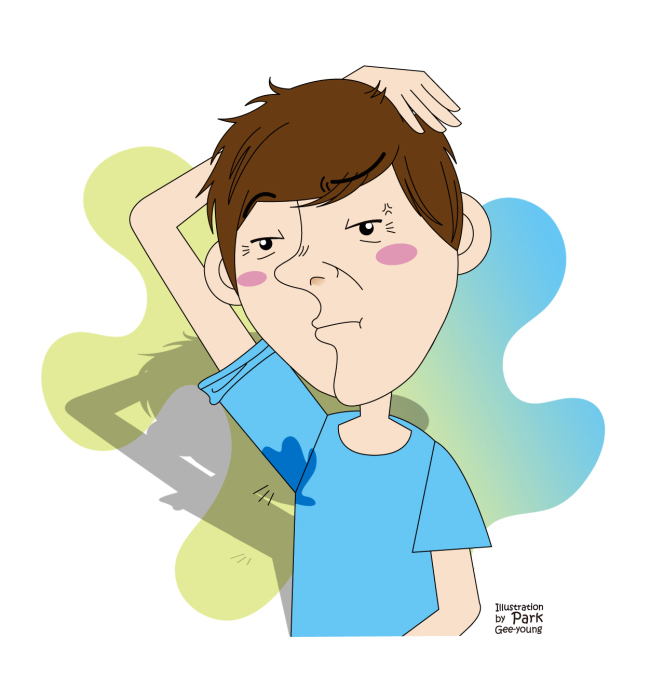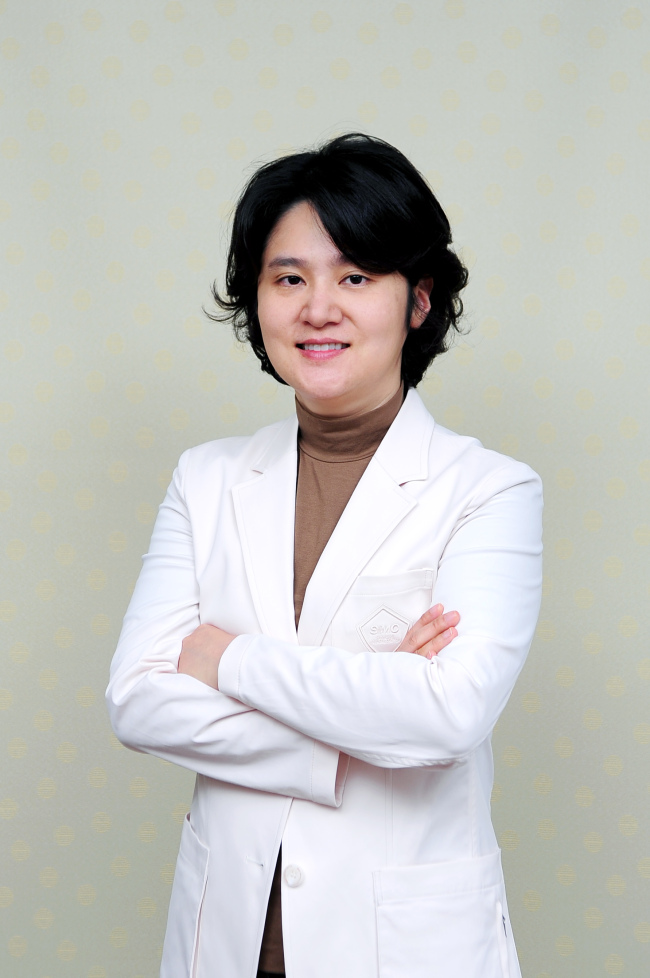There are two types of sweat glands ― the apocrine glands that produce odor, and the eccrine glands that produce ordinary sweat. Osmidrosis refers to over-secretion of the apocrine glands in the axillary region, or the armpit, causing an unpleasant underarm odor.
1. Sweat glands
Apocrine glands are distributed over the skin of the body from 4-5 months after birth, and gradually disappear, leaving behind those in only a few places such as the axilla, external auditory canal, areola, around the navel, perineum and the palpebral. However, in all other areas except the axilla, most glands have limited function and do not produce odor.

2. Composition of sweat and underarm odor
Sweat produced from the apocrine glands is milky colored, and can cause yellow discoloring of white clothing, which is difficult to remove. The sweat produced from the apocrine glands is odorless and aseptic at the time of production, but degrades within one hour of production into fatty acids and ammonia, which produces the characteristic odor.
Sweat produced from the eccrine glands is colorless and odorless, and 99 percent water. The sweat produced wets the keratin layer of the skin and this can become denatured by bacteria to produce an odor, but this is not related to underarm odor.
3. Period of osmidrosis occurrence
The apocrine glands do not function before the age of 10, and in those who are prone to developing osmidrosis. The glands enlarge suddenly after the age of 10 when the endocrine functions become more active. Osmidrosis is usually associated with the endocrine function, so does not often occur in the prepubertal or elderly population. Emotional stimuli promote the secretion from the apocrine glands, so osmidrosis occurs after puberty.
4. Incidence
In general, the apocrine glands are smaller and less active in Asians compared to Caucasians, so the incidence is lower in the Asian population (10 percent in Japan, 7 percent in Korea).
Osmidrosis is inherited in an autosomal dominant manner. According to statistics, there is a 50 percent chance of developing osmidrosis if one parent has osmidrosis, and the chance increases to 80 percent if both parents have osmidrosis. However, about 20 percent of osmidrosis patients do not have a family history.
5. Diagnosis
The diagnosis can easily be made from one’s history alone, but in order to accurately identify the sweating regions and extent, a sweat test can be performed.
The sweat test (Iodine-starch test, minor test): The patient will lift both arms and a minor solution (mixture of iodine 1.5 g, caster oil 10 ml, 95 percent alcohol 100 ml) is applied for five minutes, after which a thin layer of starch is applied.
Two 500 W bulbs are turned on at a 50-centimeter distance from each arm for three minutes to induce sweating. The starch in the areas of sweat production will change from white to a dark brown color.
6. Treatment
For those with less serious odor, conservative methods such as bathing more often and using perfumes can be used. However, this is only a temporary symptomatic relief, and the most effective and radical treatment is surgery. There are several surgical methods, which can broadly be divided into 1) skin excision, and 2) removal of hypodermic tissue.
These two methods can be done under local anesthesia, unless in special circumstances. Skin excision is done by excising skin with hair and either suturing or grafting skin. Although it is a simple procedure, it can have complications (bad scarring, decreased range of motion of the shoulder joint due to circumferential scarring of the tissue), which is why the second method, removal of hypodermic tissue, is used more widely.
In this treatment method, one or two linear excisions are made in the axillary region, to conserve the outer skin while removing the fat and the underlying dermis. It requires more delicate surgery and significant cooperation of the patient during the procedure. Unless there are any complications, the treatment will take approximately 10 to 14 days to complete.
Therefore, the patient should avoid excessive movement of the arm for three weeks. Compared to the skin excision method, this method has several advantages (milder scarring, reduced incidence of contraction scars) but requires a longer surgery and absolute rest of both shoulder joints for several days to reduce potential complications. (As an application, Inaba et al (1978) have used a tool with a blade on one end and a roller on the other end, which was inserted into the skin through a 1.5 cm incision to remove the dermis.)
1. Sweat glands
Apocrine glands are distributed over the skin of the body from 4-5 months after birth, and gradually disappear, leaving behind those in only a few places such as the axilla, external auditory canal, areola, around the navel, perineum and the palpebral. However, in all other areas except the axilla, most glands have limited function and do not produce odor.

2. Composition of sweat and underarm odor
Sweat produced from the apocrine glands is milky colored, and can cause yellow discoloring of white clothing, which is difficult to remove. The sweat produced from the apocrine glands is odorless and aseptic at the time of production, but degrades within one hour of production into fatty acids and ammonia, which produces the characteristic odor.
Sweat produced from the eccrine glands is colorless and odorless, and 99 percent water. The sweat produced wets the keratin layer of the skin and this can become denatured by bacteria to produce an odor, but this is not related to underarm odor.
3. Period of osmidrosis occurrence
The apocrine glands do not function before the age of 10, and in those who are prone to developing osmidrosis. The glands enlarge suddenly after the age of 10 when the endocrine functions become more active. Osmidrosis is usually associated with the endocrine function, so does not often occur in the prepubertal or elderly population. Emotional stimuli promote the secretion from the apocrine glands, so osmidrosis occurs after puberty.
4. Incidence
In general, the apocrine glands are smaller and less active in Asians compared to Caucasians, so the incidence is lower in the Asian population (10 percent in Japan, 7 percent in Korea).
Osmidrosis is inherited in an autosomal dominant manner. According to statistics, there is a 50 percent chance of developing osmidrosis if one parent has osmidrosis, and the chance increases to 80 percent if both parents have osmidrosis. However, about 20 percent of osmidrosis patients do not have a family history.
5. Diagnosis
The diagnosis can easily be made from one’s history alone, but in order to accurately identify the sweating regions and extent, a sweat test can be performed.
The sweat test (Iodine-starch test, minor test): The patient will lift both arms and a minor solution (mixture of iodine 1.5 g, caster oil 10 ml, 95 percent alcohol 100 ml) is applied for five minutes, after which a thin layer of starch is applied.
Two 500 W bulbs are turned on at a 50-centimeter distance from each arm for three minutes to induce sweating. The starch in the areas of sweat production will change from white to a dark brown color.
6. Treatment
For those with less serious odor, conservative methods such as bathing more often and using perfumes can be used. However, this is only a temporary symptomatic relief, and the most effective and radical treatment is surgery. There are several surgical methods, which can broadly be divided into 1) skin excision, and 2) removal of hypodermic tissue.
These two methods can be done under local anesthesia, unless in special circumstances. Skin excision is done by excising skin with hair and either suturing or grafting skin. Although it is a simple procedure, it can have complications (bad scarring, decreased range of motion of the shoulder joint due to circumferential scarring of the tissue), which is why the second method, removal of hypodermic tissue, is used more widely.
In this treatment method, one or two linear excisions are made in the axillary region, to conserve the outer skin while removing the fat and the underlying dermis. It requires more delicate surgery and significant cooperation of the patient during the procedure. Unless there are any complications, the treatment will take approximately 10 to 14 days to complete.
Therefore, the patient should avoid excessive movement of the arm for three weeks. Compared to the skin excision method, this method has several advantages (milder scarring, reduced incidence of contraction scars) but requires a longer surgery and absolute rest of both shoulder joints for several days to reduce potential complications. (As an application, Inaba et al (1978) have used a tool with a blade on one end and a roller on the other end, which was inserted into the skin through a 1.5 cm incision to remove the dermis.)

By Lim So-young
The author is a doctor at Department of Cosmetic & Plastic Surgery at Samsung Medical Center and a professor of the Sungkyunkwan Univeristy School of Medicine. ― Ed.
-
Articles by Korea Herald








![[KH Explains] Hyundai's full hybrid edge to pay off amid slow transition to pure EVs](http://res.heraldm.com/phpwas/restmb_idxmake.php?idx=644&simg=/content/image/2024/04/18/20240418050645_0.jpg&u=20240419100350)







![[From the Scene] Monks, Buddhists hail return of remains of Buddhas](http://res.heraldm.com/phpwas/restmb_idxmake.php?idx=652&simg=/content/image/2024/04/19/20240419050617_0.jpg&u=20240419175937)

![[KH Explains] Hyundai's full hybrid edge to pay off amid slow transition to pure EVs](http://res.heraldm.com/phpwas/restmb_idxmake.php?idx=652&simg=/content/image/2024/04/18/20240418050645_0.jpg&u=20240419100350)

![[Today’s K-pop] Illit drops debut single remix](http://res.heraldm.com/phpwas/restmb_idxmake.php?idx=642&simg=/content/image/2024/04/19/20240419050612_0.jpg&u=)